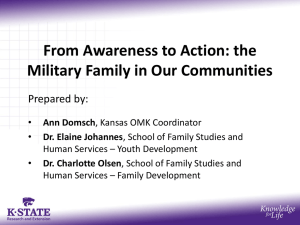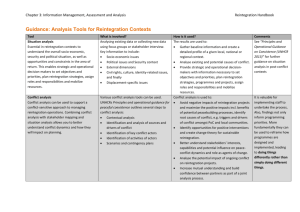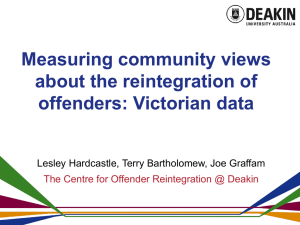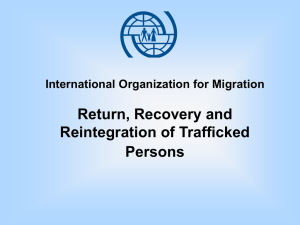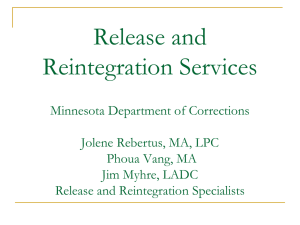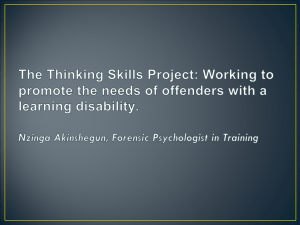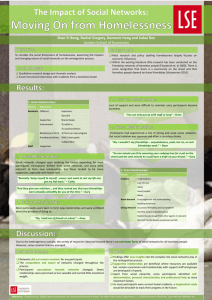Brooke and Alicia 1415
advertisement
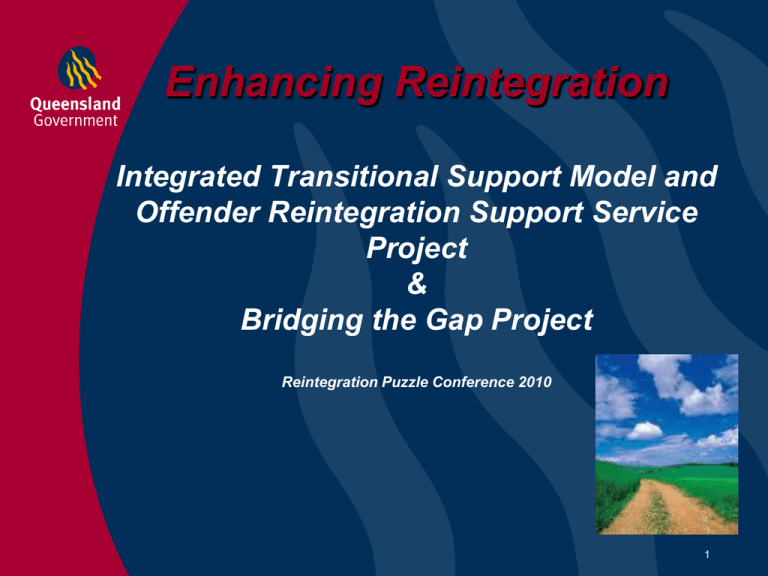
Enhancing Reintegration Integrated Transitional Support Model and Offender Reintegration Support Service Project & Bridging the Gap Project Reintegration Puzzle Conference 2010 1 Overview • Integrated Transitional Support Model – – – – Existing model Business case and funding Key products Key learnings from process to date • Bridging the Gap – Background research and business case – Key products – Key learnings from process to date Existing Transitional Support Model in Queensland • Transitions Coordinator at each Correctional Centre • Transitions Release Preparation program targeted at offenders assessed as higher risk of re-offending / higher level of reintegration need • Transitional Support Service for lower risk and shorter-term offenders • Offender Reintegration Support Service delivered by contracted NGOs • Advance2Work specialist post release employment assistance program Integrated Transitional Support Model Transitions Release Preparation Program Sentenced prisoners OR Offender Reintegration Support Service Transitional Support Service 6 months earliest release date Eligible for Support Release Background - “The Road Home” • In December 2008, the Australian Govt released the White Paper on Homelessness – “The Road Home”. • Two headline goals: – Halve overall homelessness by 2020; and – Offer supported accommodation to all rough sleepers by 2020. 5 Background – Intergovernmental Agreement National Affordable Housing Agreement $6.2b/5yrs Former SAAP services, crisis accommodation and the Commonwealth State Housing Agreement National Partnership on Homelessness $800m/4 yrs + A Place to Call Home $300m/5yrs National Partnership on Social Housing $400m/2yrs National Partnership on Remote Indigenous Housing $1.9b/10yrs Nation Building and Jobs Plan Social Housing: $6b for New Construction/3.5years $400m for Repair and Maintenance/2yrs Background - National Partnership Agreement on Homelessness • COAG established the National Partnership Agreement on Homelessness (NPAH). • Multiple key areas for reform – People exiting the custody of the State • State government submissions for funding for projects that contribute to addressing homelessness. • QCS business case for funding to enhance the Agency’s existing Integrated Transitional Support Model (ITSM) and Offender Reintegration Support Service (ORSS). Background – QCS Business Case • Research • Emphasised the success of the existing model but highlighted the need for additional funding to address gaps in service delivery. • Dedicated staffing for service delivery (Transitions Coordinators) and expansion of ORSS to include all low security facilities. • Overall, aim to reduce the risk of homelessness amongst ex-prisoners by providing assessment, support and referral to external services across the period when prisoners are preparing for release and transitioning back into the community. Project Funding • $6 m over next four financial years, $1.5 m per year 2009-10 $M 1.35 2010-11 $M 1.3 2011-12 $M 1.3 2012-13 $M 1.3 Offender Reintegration Support Service 0.15 0.2 0.2 0.2 TOTAL 1.5 1.5 1.5 1.5 Funding Breakdown Integrated Transitional Support Model Project Objective To enhance service delivery under the Integrated Transitional Support Model and expand the ORSS to provide eligible prisoners exiting custody with the opportunity to access coordinated and structured transitional support, both pre release and post release in the community. 10 Key Products Transitions Coordinators appointed and trained Integrated Transitional Support Model Review, including the Transitions Release Preparation Program Offender Reintegration expansion and re-tender Support Service Database Housing Partnerships Enhanced Service Delivery 11 Targets 2009/10 2010/11 2011/12 2012/13 Transitional support 2700 3300 3300 3300 Offender Reintegration Support Service 880 1250 1250 1250 Key Learnings Effective relationships built with Policy area within QCS who were able to advocate for the approach we were taking when seeking the funding Need to ensure sufficient dedicated staffing – including Project Manager and importance of attracting the “right” staff Balancing strategic and operational focus (i.e. balancing planning with “doing”) Need for effective change management and communication strategies with key stakeholders Need for realistic understanding of time-frames Establishing a project board for governance and oversight, with key internal senior stakeholders included to increase “buy-in” and successful implementation / raise the profile of the project Barriers in correctional staff attitudes to prisoners/reintegration A number of community agencies / other government depts interested in partnering with us to deliver the project / achieve positive reintegration outcomes. 13 BRIDGING THE GAP Throughcare Support for Offenders With Impaired Cognitive Functioning PILOT PROJECT What is Cognitive Impairment? • Cognitive impairment is a broad term used to describe a wide variety of impaired brain function relating to the ability of a person to: – – – – – – – think concentrate react to emotions formulate ideas problem solve reason and remember. • There can be a wide range of severity in impairment from mild through to severe. Cognitive impairment can be associated with many disabilities and disorders that can be present at birth or acquired later in life. • (Source: http://www.jobaccess.gov.au/JOAC/Advice/Disability/Cognitive_Impairment.htm ) Background • Research has identified that people with an ID are over-represented in the criminal justice system vs prevalence in the general community. • E.g. community estimates range from 0.3 – 3% and prison estimates range from 1.5% - 29%. Challenges in a Prison Environment • Research indicates that this population of offenders can be particularly disadvantaged and vulnerable in a prison environment. • E.g Victorian study found: – Less likely to progress to low security – Higher numbers of prison incidents recorded against them – More likely to be denied parole (typically due to unsuitable post-release accommodation) Re-Settlement Challenges • The offending behaviour of many people with cognitive impairments is a function of a complex array of unmet health, housing, economic and social needs. • Risk of “slipping through the cracks” upon release and not having access to coordinated and comprehensive systems of support. Bridging the Gap Submission • State Government’s Prevention and Early Intervention scheme (PEI). • This scheme was set up to provide funding for pilot projects in the human services field to provide prevention and early intervention services for various “vulnerable” groups within the community. • QCS made a submission for funding based on the lack of any existing specialist interventions for this group within the prison population. Business Case Successful • Total funding of $1.46 million over the next three financial years, commencing in 2009 – 2010 FY for a pilot for sentenced male and female offenders in South East Queensland. • Key deliverables: – – – – – – – – Recruitment of a Senior Adviser based in head office Recruitment of two specialist Disability Support Workers to work directly with offenders in custody Implementation of a screening tool to identify offenders with ICF at reception Procurement process to engage a specialist NGO to provide intensive reintegration support and case management during transition from custody to community (Interact Australia) Development and implementation of specialist activities and services to enhance adaptive behavioural functioning with a focus on successful reintegration Delivery of targeted staff training on managing this offender population and managing challenging behaviours appropriately Woodford Correctional Centre to pilot a specialist accommodation unit for this target population. Formal evaluation of the pilot Key Learnings Need to ensure sufficient dedicated staffing – including Project Manager and importance of attracting the “right” staff Distinguishing between ICF and mental health issues – although may be co-occuring. Included specific allocation in funding submission for a formal evaluation of the pilot Being flexible with the pilot – using it as an opportunity to trial different approaches. Need to “find” and engage key partner agencies to ensure a “joined up” approach and avoid duplication of services Bringing in expert agencies to deliver specialist training to custodial staff at Woodford unit Making training part of the core induction training available to all custodial officers. 24 Questions?

